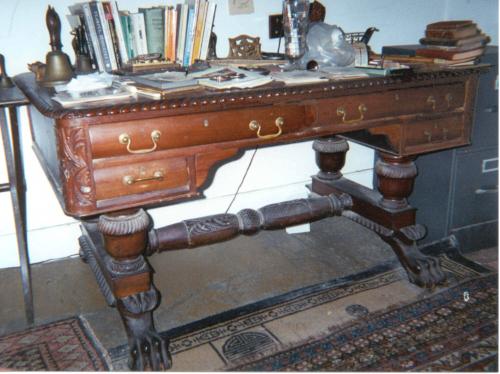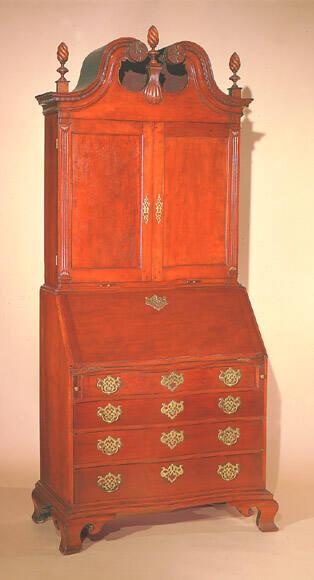Partner's Desk
Furniture MakerMade by
Unknown
Date1840-1850
MediumMahogany primary wood, tulip poplar secondary woods, brass hardware
DimensionsPrimary Dimensions (overall height x width x depth): 29 5/16 x 54 11/16 x 32 5/16in. (74.5 x 138.9 x 82.1cm)
ClassificationsFurniture
Credit LineThe Newman S. Hungerford Museum Fund
Object number2001.8.0
DescriptionMahogany partner's desk in the Empire, or late neoclassical, style. The desk has a large rectangular top with gadrooned edges. The gadrooning consists of a row of projecting lobes carved at an angle, with greater detail at each corner of the desk top. The symmetrical drawer arrangement (found on both sides of the desk) consists of two drawers side-by-side, each with a narrower drawer below it at the outside edge. A bracket with an undulating edge decorates the inside edge between each small drawer and the wider drawer above. Each curved corner of the desk has a carved panel with a flower inside a diamond, with stylized leaves at the corners. Each end of the desk has a plain recessed panel. The desk top and drawers are supported by four large, carved posts. Each post has a series of projecting and recessed rings over a band of gadrooning, over a slightly tapered portion, a recessed band, and a base with cross hatching. The posts on each end of the desk rest on a plain, rectangular, horizontal support that connects them. The two supports are themselves connected across the middle of the desk by a thick, round stretcher that is carved with a symmetrical pattern of cross hatching and leaves. Each support sits on a gadrooned base; each end of the base curves down to a foot carved with a large animal paw. Each paw faces outward and has clearly defined knuckles and claws. Hardware includes a brass-lined keyhole flanked by a pair of ring-and-bail pulls on each of the drawers in the top row. Each lower drawer has a brass-lined keyhole over a single brass ring-and-bail pull. Each foot rests on a caster.
Condition: The top of the desk is lightly scratched and worn. The claws on each carved-paw foot are scratched and worn. The finish on one side of the desk is a lighter shade than the other. The left ring-and-bail pull on the upper left drawer on the faded side of the desk is detached.
Design and Construction Details: The top is constructed of three boards; the gadrooning is carved into the edges of these boards. The top is screwed from below into the sides of the desk. The case is constructed of horizontal rails that are joined to the solid, vertical, carved, panels at each corner. Each end of the desk consists of a rail at the top and bottom, with a full-height, full-width vertical board inside the desk, secured to the interior edges of the rails to imitate a recessed panel. Each curved bracket is nailed to the underside of the drawer divider. Cock beading is nailed to the bottom of the case, but only below the lower drawers. Below each pair of lower drawers, a full-depth board is screwed to the underside of the case, on each end of the desk. The four supporting posts are joined to this board with three dowels for each post. The posts and the stretcher are made of wood that has been laminated, then turned and carved. The supports beneath the posts are joined to the gadrooning and feet with screws and dowels.
Drawer Construction: Each rail above each upper drawer, each drawer divider, and each rail below each lower drawer is joined to the solid panels at each corner of the desk. The vertical partition between the top two drawers on each side is nailed into place. The vertical partition between each lower drawer and bracket is also nailed in place; a vertically-oriented board extends the depth of the case, attaching the vertical partition to its counterpart on the opposite side of the desk. The drawer runners are nailed to the sides of the case. The center drawer runner for the top drawers of the desk consists of a single brace that extends the full depth of the desk; it is also nailed in place. Each drawer guide is nailed in place. Each drawer front is solid, with a horizontally projecting curved surface. Each drawer is constructed with dovetails. The bottom boards of each drawer run from side to side and have chamfered edges. Each drawer bottom fits into grooves in the front and sides of the drawer and is nailed at the back. There is no internal partition or drawer stop between the drawers on either side of the desk.
NotesUse Note: A partner's desk is designed so that two people can use the desk while sitting face-to-face; each side is symmetrical. This desk (2001.8.0) was used as a writing desk by noted African-American novelist Ann Petry. Petry used one side of the desk for writing; it was pushed up against the wall in her room (see photograph). This resulted in one side of the desk fading slightly from exposure to the sun. (Hunt 11/11/2005)Condition: The top of the desk is lightly scratched and worn. The claws on each carved-paw foot are scratched and worn. The finish on one side of the desk is a lighter shade than the other. The left ring-and-bail pull on the upper left drawer on the faded side of the desk is detached.
Design and Construction Details: The top is constructed of three boards; the gadrooning is carved into the edges of these boards. The top is screwed from below into the sides of the desk. The case is constructed of horizontal rails that are joined to the solid, vertical, carved, panels at each corner. Each end of the desk consists of a rail at the top and bottom, with a full-height, full-width vertical board inside the desk, secured to the interior edges of the rails to imitate a recessed panel. Each curved bracket is nailed to the underside of the drawer divider. Cock beading is nailed to the bottom of the case, but only below the lower drawers. Below each pair of lower drawers, a full-depth board is screwed to the underside of the case, on each end of the desk. The four supporting posts are joined to this board with three dowels for each post. The posts and the stretcher are made of wood that has been laminated, then turned and carved. The supports beneath the posts are joined to the gadrooning and feet with screws and dowels.
Drawer Construction: Each rail above each upper drawer, each drawer divider, and each rail below each lower drawer is joined to the solid panels at each corner of the desk. The vertical partition between the top two drawers on each side is nailed into place. The vertical partition between each lower drawer and bracket is also nailed in place; a vertically-oriented board extends the depth of the case, attaching the vertical partition to its counterpart on the opposite side of the desk. The drawer runners are nailed to the sides of the case. The center drawer runner for the top drawers of the desk consists of a single brace that extends the full depth of the desk; it is also nailed in place. Each drawer guide is nailed in place. Each drawer front is solid, with a horizontally projecting curved surface. Each drawer is constructed with dovetails. The bottom boards of each drawer run from side to side and have chamfered edges. Each drawer bottom fits into grooves in the front and sides of the drawer and is nailed at the back. There is no internal partition or drawer stop between the drawers on either side of the desk.
Owner Note: Ann Lane Petry (1908-1997) was an African American novelist, journalist, and biographer. Her 1946 best selling novel, The Street, was the first novel by an African American writer to sell over one million copies. Petry was born in Old Saybrook, Connecticut, and graduated from the University of Connecticut in 1931 with a degree in pharmacy. From 1931 to 1938, she worked in her family's drugstore, before moving to New York City to become a writer. She began her career as a journalist, writing for the Amsterdam News (1938-41) and the Peoples' Voice of Harlem (1941-44). She then studied creative writing at Columbia University (1944-46). Works by Ann Petry include The Street (1946), Country Place (1947), The Narrows (1953), and Miss Muriel and Other Stories (1971). Petry moved back to Old Saybrook in 1948 and lived there until her death in 1997.
According to Elisabeth (Liz) Ann Petry, of Middletown, Connecticut, her mother, Ann Petry, used the partner's desk (2001.8.0) for writing. It stood upstairs in Ann Petry's room for as long as Liz Petry can remember. (The Petry's moved into their home in Old Saybrook in 1947). Ann Petry also had a smaller, more delicate desk downstairs, which she used for correspondence. (Schoelwer 8/27/2001)
Status
Not on view








